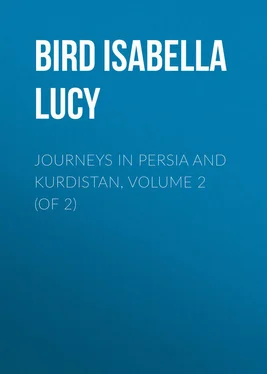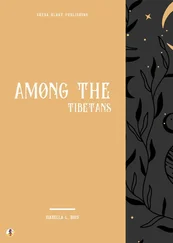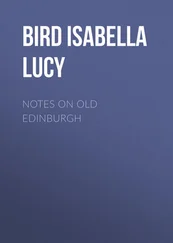Isabella Bird - Journeys in Persia and Kurdistan, Volume 2 (of 2)
Здесь есть возможность читать онлайн «Isabella Bird - Journeys in Persia and Kurdistan, Volume 2 (of 2)» — ознакомительный отрывок электронной книги совершенно бесплатно, а после прочтения отрывка купить полную версию. В некоторых случаях можно слушать аудио, скачать через торрент в формате fb2 и присутствует краткое содержание. ISBN: , Жанр: foreign_language, foreign_antique, foreign_prose, Путешествия и география, на английском языке. Описание произведения, (предисловие) а так же отзывы посетителей доступны на портале библиотеки ЛибКат.
- Название:Journeys in Persia and Kurdistan, Volume 2 (of 2)
- Автор:
- Жанр:
- Год:неизвестен
- ISBN:http://www.gutenberg.org/ebooks/38828
- Рейтинг книги:5 / 5. Голосов: 1
-
Избранное:Добавить в избранное
- Отзывы:
-
Ваша оценка:
- 100
- 1
- 2
- 3
- 4
- 5
Journeys in Persia and Kurdistan, Volume 2 (of 2): краткое содержание, описание и аннотация
Предлагаем к чтению аннотацию, описание, краткое содержание или предисловие (зависит от того, что написал сам автор книги «Journeys in Persia and Kurdistan, Volume 2 (of 2)»). Если вы не нашли необходимую информацию о книге — напишите в комментариях, мы постараемся отыскать её.
Journeys in Persia and Kurdistan, Volume 2 (of 2) — читать онлайн ознакомительный отрывок
Ниже представлен текст книги, разбитый по страницам. Система сохранения места последней прочитанной страницы, позволяет с удобством читать онлайн бесплатно книгу «Journeys in Persia and Kurdistan, Volume 2 (of 2)», без необходимости каждый раз заново искать на чём Вы остановились. Поставьте закладку, и сможете в любой момент перейти на страницу, на которой закончили чтение.
Интервал:
Закладка:
There are two definite objects of interest close to the plain of Chaman Kushan, the reputed source of the Karun and the great artificial cleft of Kar Kanun. I visited the first on a misty day, which exaggerated the height of the mountains, and by filling their chasms with translucent blue atmosphere gave a rare loveliness to the whole, for it must be said that the beauties of Persian scenery are usually staring, hard, and unveiled. The fords of two or three rivers, including the Karun, some steep ascents and descents, a rough ride along a stony slope of the Zard Kuh, and the crossing of a very solid snow-bridge took us to the top of a cliff exactly opposite the powerful springs in which the Karun has its reputed origin.
Over this source towers the mighty range of the Zard Kuh, – a colossal mountain barrier, a mass of yellow and gray limestone, with stupendous snow-filled chasms, huge precipices, and vast snow-fields, treeless and destitute of herbage except where the tulip-studded grass runs up to meet the moisture from the snow-fields. It is the birthplace of innumerable torrents, but one alone finds its way to the sea.
These springs are in a lateral slit in a lofty limestone precipice below a snow-field, at one end of which, as if from a shaft, the most powerful of them wells up, and uniting with the others in a sort of grotto of ferns and mosses pours over a ledge in a sheet of foam, a powerful waterfall, and slides away, a vigorous river of a wonderful blue-green colour, under a snow-bridge, starting full fledged on its course. The surroundings of this spring are wild and magnificent. A few Bakhtiaris crept across the lower part of the face of rock, and perched themselves above it. The roar of the water, now loud, now subdued, made wild music, and the snow-bridges added to the impressiveness of the scene.
Of course the geographical interest of this region is engrossing. 2 2 A few geographical paragraphs which follow here and on p. 35 are later additions to the letter.
This remarkable spring, called by the Bakhtiaris Sar-i-Cheshmeh-i-Kurang ("the head source of the Kurang"), and until this journey held to be the real source, is not, however, the actual birthplace of the Karun or Kurang, which was afterwards traced up to its headwaters in the magnificent Kuh-i-Rang. 3 3 Although the correct name of this river is undoubtedly Kurang, I have throughout adopted the ordinary spelling Karun , under which it is commercially and politically known.
A few words on this, the one real river of which Persia can boast, and which seems destined to play an important part in her commercial future, will not be out of place. From its source it is a powerful and important stream, full, deep, and flowing with great velocity for much of its upper course between precipices varying in height from 1000 to 3000 feet. It is a perennial stream, fordable in very few places, and then only in its upper waters. Varying in width usually from fifty to a hundred yards, it is compressed at the Pul-i-Ali-kuh into a breadth of about nine feet.
The steepness and height of its banks make it in general useless for irrigation purposes, but some day it may be turned to account as a great "water power." Its windings, dictated by the singular formation of the mountain ranges (for I reject the idea of it having "carved" its channel), are almost phenomenal. After flowing south-east for a hundred miles from its source, it makes an acute bend, flows for fifty miles to the south-west, and then making another fantastic turn it flows in an exactly opposite direction to that of its earlier course, proceeding north-west to Shuster for a hundred miles.
It is calculated that the distance from the Kuh-i-Rang to Shuster as the crow flies is seventy-five miles, but the distance travelled by the waters of the Karun is 250 miles, with an aggregate fall of 9000 feet.
Besides being fed on its journey through the Bakhtiari country by many mountain-side fountain springs of pure fresh water, as well as by salt streams and springs, it receives various tributaries, among the most important of which are the Ab-i-Bazuft and a stream which, though known locally under various names, may be called from the Chigakhor basin in which it rises the Ab-i-Chigakhor, which makes a course of ninety miles to get over a distance of twenty; the Darkash Warkash flowing in from the Chahar Mahals near Ardal, the Dinarud rising in the fair valley of Gorab, and the Ab-i-Cherri or Duab.
This mountain range, the Zard Kuh, in whose steep side at a height of over 8000 feet the Sar-i-Cheshmeh-i-Kurang wells up so grandly, is rather a series of rock summits and precipices than a range of mountains. In late June its naked shelves and battlements upbore great snow-fields, and its huge rifts or passes – the Gil-i-Shah, nearly 11,700 feet in altitude, and the Pambakal, 11,400 – were full of snow. But even in four days it melted rapidly, and probably by August little remains except a few patches, in the highest and most sunless of the rifts. It is only on the north side that the snow lasts even into July.
The marked features of this range are its narrow wall-like character, its ruggedness on both sides, its absence of any peaks rising very remarkably above the ordinary jagged level of the barrier, its lack of prominent spurs, and its almost complete nakedness. It is grand, but only under rare atmospheric conditions can it be termed beautiful. Its length may be about thirty miles. It runs from north-west to south-east. Some of its highest summits attain an elevation of 13,000 feet. Its name is a corruption of Sard Kuh, "cold mountain."
After fording various snow streams and taking a break-neck goat track, we reached the great snow pass of Gil-i-Shah, by which the Bakhtiaris come up from the Shuster plains on the firm snow in spring, returning when the snow is soft in autumn by a very difficult track on the rocky ledges above. In the mist it looked the most magnificent and stupendous pass I had ever seen, always excepting the entrance to the Lachalang Pass in Lesser Tibet, and an atmospheric illusion raised the mountains which guard it up to the blue sky. I much wished to reach the summit, but in a very narrow chasm was fairly baffled by a wide rift in a sort of elevated snow-bridge which the mule could not cross, and camped there for some hours; but even there nomads crowded round my tent with more audacity in their curiosity than they usually show, and Mirza heard two of them planning an ingenious robbery.
The heat was very great when I returned, 100° in the shade, but rest was impossible, for numbers of mares and horses were tethered near my tent, and their riders, men and women, to the number of forty, seized on me, clamouring for medicines and eye lotions. I often wonder at the quiet gravity of Mirza's face as he interprets their grotesque accounts of their ailments. A son of Chiragh Ali Khan came to tell me that the "Feringhi ointment" had cured a beautiful young woman of his tribe of an "abscess in her nose"! An instance of real benefit hardly consoles for many failures, and any cure increases the exhausting number of "patients." On one day on that plain there was no rest between eleven and five.
Small events occurred tending to show that the good order which the Ilkhani's government secures is chiefly round the centre of rule. Stories of tribal disputes with violence, and of fights arising out of blood feuds came in daily, and recent sword cuts and bullet wounds were brought to the Hakīm . One day there was a disturbance in camp owing to a man attacking Hassan for preventing a woman from entering my tent in my absence. I learned very soon after coming into this country that the Bakhtiaris are dangerously sensitive about their women, although the latter are unveiled and have an amount of latitude unusual in the East. I have more than once cautioned my servants on this point, for any supposed insult to a female relative of a Bakhtiari would have by custom to be wiped out in blood. This extreme sensitiveness has its good side, for even in the midst of the tribal wars and broils which are constantly occurring female honour is always secure, and a woman can travel safely alone through the wildest regions; a woman betraying her husband would, however, almost certainly be put to death. One night the camps were threatened by robbers, upon whom Aziz Khan fired.
Читать дальшеИнтервал:
Закладка:
Похожие книги на «Journeys in Persia and Kurdistan, Volume 2 (of 2)»
Представляем Вашему вниманию похожие книги на «Journeys in Persia and Kurdistan, Volume 2 (of 2)» списком для выбора. Мы отобрали схожую по названию и смыслу литературу в надежде предоставить читателям больше вариантов отыскать новые, интересные, ещё непрочитанные произведения.
Обсуждение, отзывы о книге «Journeys in Persia and Kurdistan, Volume 2 (of 2)» и просто собственные мнения читателей. Оставьте ваши комментарии, напишите, что Вы думаете о произведении, его смысле или главных героях. Укажите что конкретно понравилось, а что нет, и почему Вы так считаете.












